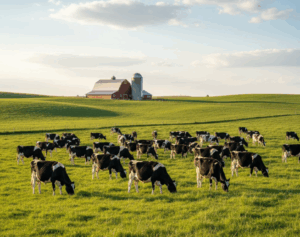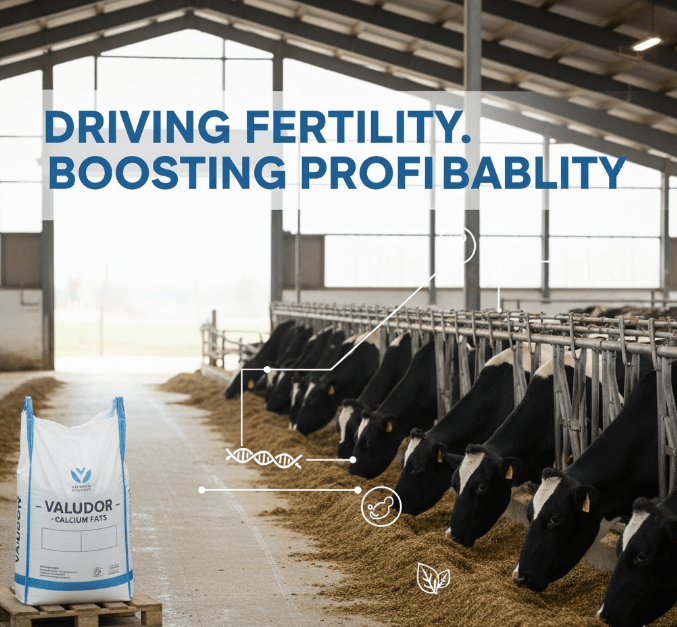The productive efficiency of a dairy herd is anchored entirely in its reproductive health, making fertility its true economic engine. he reality is that reproductive challenges persist across the industry—high-producing fresh cows frequently face profound negative energy balance, resulting in delayed estrus, poor conception rates, and calving intervals that stretch profitability to its limit.
This crucial gap between peak production and peak fertility is not merely a biological curiosity; it’s a significant financial leakage point where a substantial portion of hard-earned profit often evaporates. Recognizing the magnitude of this problem, relying on generalized feeding strategies is no longer sufficient. Therefore, effectively closing this debilitating gap—stabilizing the cow during her most stressful period—demands a sophisticated, highly targeted nutritional solution, and the proven mechanism for achieving that lies fundamentally within precision dairy nutrition.
Fertility as a Profitability Driver
For dairy farms managing 500+ cows, fertility determines long-term productivity. Every extra day open costs $3–$5, and each missed conception cycle delays milk and calf revenue. Energy balance is the single biggest driver of reproductive success. Cows in negative energy balance (NEB) experience delayed estrus, poor ovulation, and higher early embryo loss.
Calcium salts of fatty acids (CaFA) are a precision nutritional tool engineered to overcome energy deficits without rumen disruption. This targeted energy supply empowers the high-producing dairy cow to rapidly recover postpartum, enabling her to cycle sooner and achieve a higher rate of conception.
The Energy–Reproduction Link
- Glucose and fertility: Energy deficits shift nutrients away from reproductive processes to maintain milk synthesis.
- NEFA & fertility: High circulating NEFA from body fat mobilization interferes with ovarian function and oocyte quality.
- Hormonal disruption: NEB delays luteinizing hormone (LH) surge and ovulation.
Nutritionists need strategies that deliver energy without overloading the rumen—this is where calcium salts excel.
Calcium Salts Support Fertility
Calcium salts bypass rumen degradation, ensuring fatty acids reach the small intestine intact. The outcomes:
- Higher conception rates: Energy availability supports embryo survival.
- Improved uterine health: Reduced metabolic stress lowers postpartum infections.

Scientific Evidence
University of Illinois Study
Cows supplemented with calcium salts had shorter intervals to first ovulation and higher conception rates compared to unsupplemented controls (Staples et al., 1998).
Cornell University Trial
CaFA-fed cows showed improved energy balance and lower early embryonic loss (Lucy, 2001).
Brazilian Research (USP, Pirassununga)
Supplementing CaFA increased pregnancy rates by 10% and reduced days open by 14 days in high-yielding herds.
Sustainability and Fertility
- Fewer replacement heifers needed: Extending cow longevity reduces rearing costs and methane per liter of milk.
- Lower resource intensity: Each additional lactation spreads emissions over more milk produced.
- Improved herd stability: Fewer health culls mean more consistent herd structures and less volatility in production.
For more on sustainable herd strategies, explore our Dairy Blog.
Practical Feeding Strategies
- Target stage: Transition period and early lactation.
- Inclusion level: 3–5% of dietary DM.
- Fatty acid selection:
- Palmitic acid (C16:0): Enhances milk fat and energy density.
- Oleic acid (C18:1): Improves digestibility and supports reproductive tissues.
- Ration balance: Avoid excess starch to prevent rumen acidosis, pair fats with optimal forage-to-concentrate ratios.
ROI from Improved Fertility
- Average cost of days open: ~$4/day.
- A reduction of 14 days open across 500 cows saves $28,000 annually.
- Increased conception rate = fewer inseminations, lower semen costs, and less labor.
Combined with milk yield gains, calcium salts deliver a compounded ROI.
Long-Term Herd Sustainability
Fertility improvements translate into:
- Longer productive lifespans.
- More stable replacement strategies.
- Reduced greenhouse gas emissions per kg of milk.
For nutritionists, this aligns with both profitability and consumer-driven sustainability goals.
Case Example – Midwest Dairy Herd
A 750-cow herd in Wisconsin added calcium salts (5% DM) to its transition ration. Outcomes:
- Days open dropped from 145 to 131.
- Conception rate improved from 32% to 38%.
- Milk yield increased by 2.8 kg/day.
Net ROI exceeded $40,000 annually when accounting for improved reproduction and milk solids.
Implementing Calcium Salt Programs
- Monitor reproduction KPIs: Days open, services per conception, conception rate.
- Phase in supplementation: Start 3 weeks pre-calving, continue through 60 DIM.
- Collaborate with suppliers: Source high-quality CaFA from trusted providers.
- Evaluate outcomes quarterly: Align nutrition with reproduction goals.

Conclusion
Fertility is not merely a metric; it is the cornerstone of profitable and sustainable dairy production. Moving beyond the immediate energy challenge, the strategic use of calcium salts of fatty acids offers nutritionists a reliable, research-proven tool for long-term herd management. By consistently delivering rumen-protected energy, these supplements directly enable cows to overcome early lactation stress, leading to significant physiological benefits: shorter calving intervals, enhanced conception rates, and a measurable reduction in costly replacement rates.
Ultimately, the successful integration of a precise nutritional strategy like calcium salts of fatty acids establishes a new performance baseline, yielding a clear and sustainable return on investment. This approach culminates in a virtuous cycle of biological and economic benefits: the energy stabilization ensures healthier cows with greater longevity, which, in turn, drives dramatically stronger profit margins via improved milk and reproductive efficiency. Crucially, this fundamental resilience builds a dairy operation uniquely positioned to thrive long-term—meeting both the rigorous demands of an efficiency-driven market and the growing pressure for environmental and animal welfare sustainability.
References
- Staples, C.R., Burke, J.M., & Thatcher, W.W. (1998). Influence of supplemental fats on reproductive tissues and performance of lactating cows. Journal of Dairy Science.
- Lucy, M.C. (2001). Reproductive loss in high-producing dairy cattle: Where will it end? Journal of Dairy Science.
- Lopes, C.N., Cooke, R.F., Reis, M.M., & Vasconcelos, J.L.M. (2009). Supplemental fatty acids in dairy cow diets and reproductive outcomes. Livestock Science.
- Leroy, J.L.M.R., Vanholder, T., Opsomer, G., Van Soom, A., & de Kruif, A. (2006). The effect of negative energy balance on oocyte and embryo quality in cattle. Reproduction in Domestic Animals.
- USDA Dairy Reproductive Efficiency Report (2020). https://www.ers.usda.gov
The modern dairy challenge: how do you consistently improve cow fertility without compromising your farm’s sustainability goals? Contact our team.
